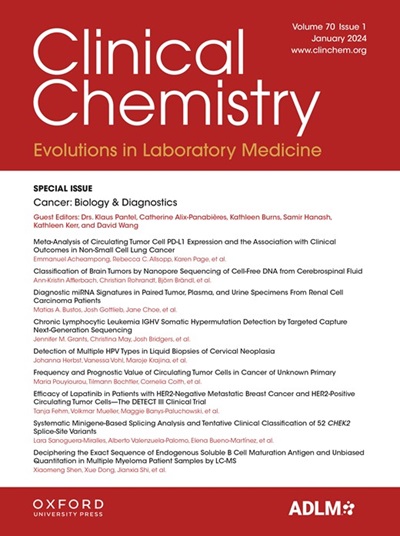A-296 Streck 尿液保存剂为 Cepheid Xpert CT/NG 检测提供样品稳定性
IF 7.1
2区 医学
Q1 MEDICAL LABORATORY TECHNOLOGY
引用次数: 0
摘要
背景性传播感染(STI)是全球最常见的传染病之一,与严重的发病率和死亡率有关。数据显示,衣原体、淋病、滴虫病和梅毒这四种可治愈的性传播疾病每年造成超过 3.75 亿人感染。此外,在美国,淋病的感染率增加了 63%,耐药淋病的出现是全球公共卫生亟待解决的问题。为了防止淋病和其他可治愈的性传播疾病的传播,并最大限度地减少未经治疗的感染的升级,早期有效的预防和控制策略至关重要。快速诊断检测和核酸扩增检测(NAATs)已成为检测性传播感染的黄金标准。然而,由于全球获取这些技术的途径有限,往往需要将样本运送到中心实验室进行分析。目前的规程建议,如果将尿液保存在 2 °C 至 8 °C 的温度下,则应在采集后 24 小时内进行分析;如果将尿液冷冻,则应在 4 天内进行分析,因为长时间保存和暴露在冻融环境中会导致细胞裂解和核酸酶释放,从而导致 DNA 降解和假阴性检测结果。如果不对样本进行稳定处理,实验室就只有很小的窗口期来进行准确分析。在此,我们证明了 Streck Urine Preserve (SUP) 可在长期储存过程中保持目标 DNA 和供体 DNA 的浓度,而且这些稳定化样本与 Cepheid 的自动 GeneXpert 系统和相关的 Xpert CT/NG 检测兼容。方法 对未添加或添加了淋病奈瑟菌(N. gonorrhoeae)的新鲜人体尿液(含或不含 SUP)进行检测。样本在室温下保存最长 18 天,然后在 Cepheid GeneXpert 系统上按照制造商的说明使用 Xpert CT/NG 检测法进行分析。比较样本处理对照组、样本充分性对照组和淋球菌目标组的平均 Ct 值差异。在整个研究期间,通过比较新鲜样本和经 SUP 处理样本之间的变化来评估 DNA 的稳定性。结果 经过长时间储存后,未经处理的纯净尿液的 Ct 值增加了 3-7 个周期,与使用 SUP 稳定的尿液样本相比,淋球菌和样本充分性对照的可检测拷贝数减少了 10 到 100 倍。在整个研究期间,使用 SUP 稳定的样本的平均 Ct 值变化不超过 1.5 个周期。此外,样本处理对照的 Ct 值在整个测试期间保持不变,表明 SUP 不会影响样本处理。结论 当有限的床旁检测方案需要将样本储存并运送到中心实验室时,尿液稳定剂对于获得代表采集时患者样本的结果至关重要。在使用 Cepheid Xpert CT/NG 检验分析之前,SUP 能有效稳定淋球菌 DNA 和供体 DNA。这与未经稳定化处理的尿液中的 DNA 拷贝数在研究期间明显下降形成了鲜明对比,这可能会导致低阳性尿液样本出现假阴性结果。总之,SUP 为临床研究人员和化验开发人员处理、运输和加工尿液标本提供了更大的灵活性,并支持与自动 NAAT 系统和化验的兼容性。本文章由计算机程序翻译,如有差异,请以英文原文为准。
A-296 Streck Urine Preserve Provides Sample Stability for Cepheid Xpert CT/NG test
Background Sexually transmitted infections (STIs) are one of the most common communicable diseases worldwide and are associated with significant morbidity and mortality. Data indicates that the four curable STIs - chlamydia, gonorrhea, trichomoniasis, and syphilis - cause over 375 million infections annually. Further, the infection rate for gonorrhea has increased by 63% in the United States and the emergence of resistant gonorrhea is an urgent global public health concern. To prevent transmission of gonorrhea and other curable STIs and minimize the escalation of untreated infections, early and effective prevention and control strategies are paramount. Rapid diagnostic testing and nucleic acid amplification tests (NAATs) have become the gold standard for STI detection. However, limited global access to these technologies often requires that samples be shipped to central laboratories for analysis. Current protocols recommend that neat urine be analyzed within 24 hours of collection if stored at 2 °C to 8 °C or within four days if frozen, as prolonged storage and exposure to freeze-thaws can induce cell lysis and release of nucleases, leading to degradation of DNA and false negative test results. Without sample stabilization, laboratories are left with a small window for accurate analysis. Here, we demonstrate that Streck Urine Preserve (SUP) maintains target and donor DNA concentrations during prolonged storage and that these stabilized samples are compatible with Cepheid’s automated GeneXpert System and associated Xpert CT/NG test. Methods Fresh human urine, with or without SUP, was tested neat or spiked with Neisseria gonorrhoeae (N. gonorrhoeae). Samples were stored at room temperature for up to 18 days before being analyzed on the Cepheid GeneXpert System using the Xpert CT/NG test per manufacturer’s instructions. Differences in average Ct values were compared for the sample processing control, sample adequacy control, and N. gonorrhoeae targets. DNA stability was assessed by comparing the changes between fresh and SUP-treated samples throughout the study period. Results Following prolonged storage, Ct values for neat, untreated urine increased by 3-7 cycles, correlating to a 10- to 100-fold decrease in detectable copies of N. gonorrhoeae and the sample adequacy control compared to urine samples stabilized with SUP. The average Ct value for samples stabilized with SUP did not change by more than 1.5 cycles throughout the study period. Additionally, Ct values for the sample processing control remained constant throughout the testing period, indicating that SUP did not impact sample processing. Conclusions When limited point-of-care testing options require storage and shipping of samples to central laboratories, urine stabilizers are imperative to obtain results representative of the patient sample at the time of collection. SUP effectively stabilized N. gonorrhoeae DNA and donor DNA prior to analysis with the Cepheid Xpert CT/NG test. This contrasts with the marked decrease in DNA copy number in non-stabilized urine over the study duration, which may lead to false negative results for low-positive urine samples. Taken together, SUP provides clinical researchers and assay developers with added flexibility when handling, shipping, and processing urine specimens and supports compatibility with automated NAAT systems and tests.
求助全文
通过发布文献求助,成功后即可免费获取论文全文。
去求助
来源期刊

Clinical chemistry
医学-医学实验技术
CiteScore
11.30
自引率
4.30%
发文量
212
审稿时长
1.7 months
期刊介绍:
Clinical Chemistry is a peer-reviewed scientific journal that is the premier publication for the science and practice of clinical laboratory medicine. It was established in 1955 and is associated with the Association for Diagnostics & Laboratory Medicine (ADLM).
The journal focuses on laboratory diagnosis and management of patients, and has expanded to include other clinical laboratory disciplines such as genomics, hematology, microbiology, and toxicology. It also publishes articles relevant to clinical specialties including cardiology, endocrinology, gastroenterology, genetics, immunology, infectious diseases, maternal-fetal medicine, neurology, nutrition, oncology, and pediatrics.
In addition to original research, editorials, and reviews, Clinical Chemistry features recurring sections such as clinical case studies, perspectives, podcasts, and Q&A articles. It has the highest impact factor among journals of clinical chemistry, laboratory medicine, pathology, analytical chemistry, transfusion medicine, and clinical microbiology.
The journal is indexed in databases such as MEDLINE and Web of Science.
 求助内容:
求助内容: 应助结果提醒方式:
应助结果提醒方式:


